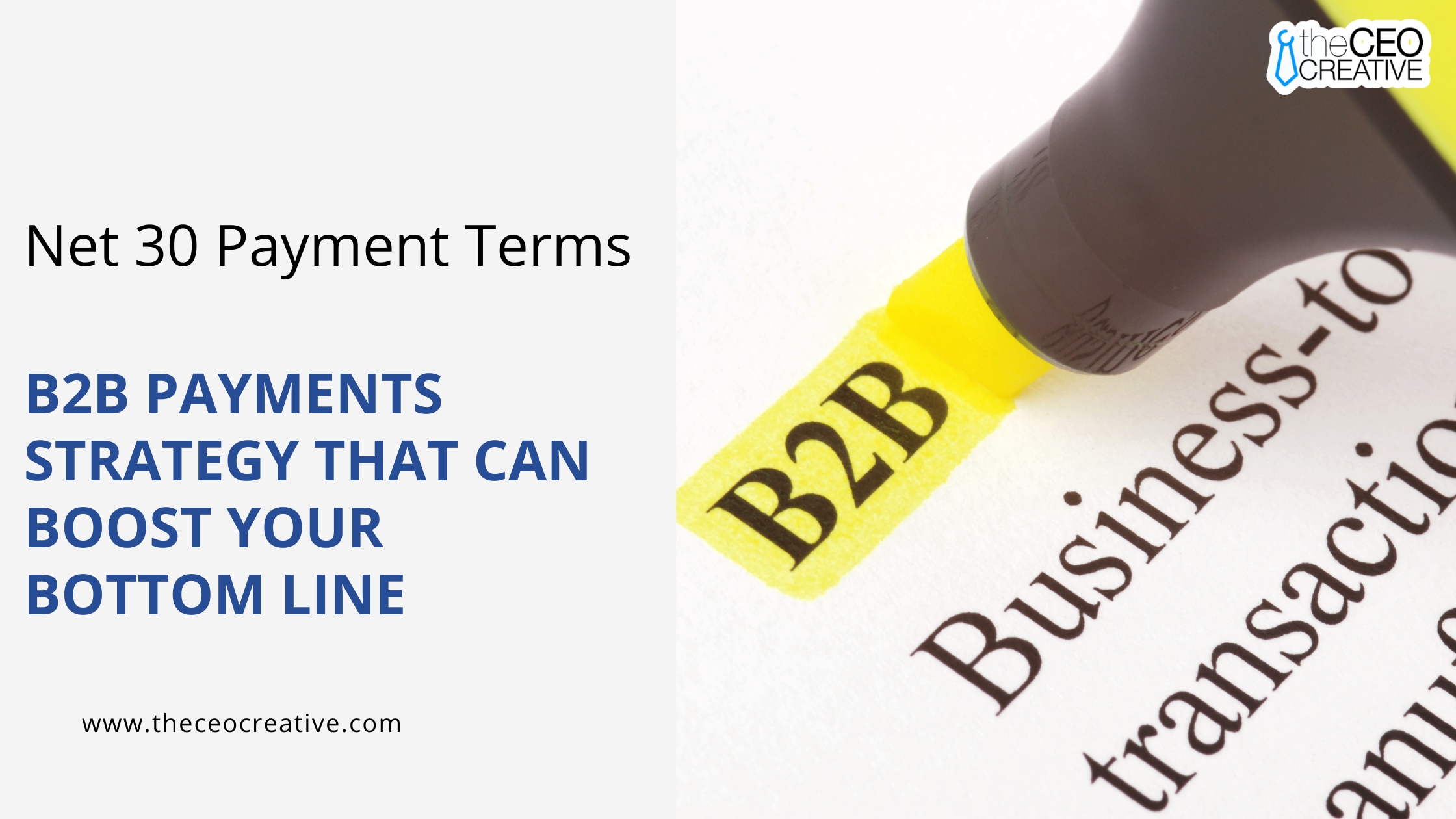Introduction to Net 30: A B2B Payments Strategy
Welcome to the intricate world of B2B transactions, where how and when you get paid can make or break your financial strategy. Enter the concept of Net 30, a payment term that’s been a trusty ally in the business community for quite some time.
Essentially, Net 30 is an agreement where buyers have a 30-day window to settle their debt, following the invoice date. This might sound simple, but it’s a powerful form of trade credit that can nurture trust between sellers and buyers.
By giving buyers a bit of breathing room to handle their cash flow and operational costs, Net 30 becomes a lifesaver. Whether you’re trying to boost your bottom line or build strong customer relationships, understanding the basics and advantages of Net 30 is essential for thriving in the B2B Payments Landscape.
Understanding Net 30
Definition and Explanation
In the bustling world of business-to-business (B2B) transactions, “Net 30” stands out as a frequently used term. But what does it really mean? Simply put, Net 30 is a financial agreement between a buyer and a seller where the buyer has 30 days from the invoice date to pay the full amount owed.
Think of it as a form of trade credit or an extension of trust from the seller to the buyer. This credit term allows businesses to acquire goods or services while taking a breather before the payment is due, thus helping them manage their cash flow efficiently.
Net 30 is more than just a convenience—it’s a standard practice rooted deeply within the B2B payments landscape. This 30-day grace period isn’t random; it’s designed to offer businesses ample time to assess the quality of the products or services, maybe even turn that purchase into revenue, before needing to settle the payment. As such, it maintains a balance of trust and flexibility in B2B transactions, making it a preferred choice for many.
Importance in the B2B Payments Landscape
Net 30 is significant in the B2B world because it underpins a substantial portion of commercial dealings, especially those involving recurring transactions or bulk orders. It serves as a financial lifeline for businesses, particularly smaller enterprises, enabling them to operate smoothly without the immediate financial burden. The structure of Net 30 supports not only the flow of goods and services but also the cultivation of long-term business relationships.
Businesses benefit from the assurance that they can secure necessary products or services even when instant payment isn’t feasible. This payment strategy also aligns with the cash flow cycles of many companies, fostering a business environment where trust and collaboration can flourish.
Advantages of Net 30 for B2B Companies
Benefits for the Seller
Net 30 is a boon for sellers, offering a multitude of advantages beyond simply deferring payments:
– Boosting Sales and Customer Base: By providing flexible payment terms, sellers can appeal to a broader swath of potential customers, including those wary of immediate payments. This can lead to increased sales and an expanded, diverse customer base.
– Competitive Edge: In a world where competition is fierce, offering Net 30 terms can differentiate a seller from those requiring upfront payment. It’s an attractive feature for businesses seeking more extended payment arrangements.
– Nurturing Loyalty: Extending trust through Net 30 can foster goodwill and loyalty, transforming what begins as a transaction into a long-term relationship. This enhances customer retention and encourages referrals.
– Facilitating Cash Flow Management: While payment is delayed, sellers can plan for upcoming cash inflows and align their expenses accordingly, leading to stable financial planning and forecasting.
– Reducing Bad Debt and Collections: Giving buyers time to generate revenue from their purchases can enhance their ability to make timely payments, ultimately reducing the risk of bad debt.
Benefits for the Buyer
From a buyer’s perspective, Net 30 is not just about delayed payments; it’s a strategic tool that offers:
– Enhanced Cash Flow: The 30-day window allows for strategic planning around cash reserves, helping businesses optimize their financial flow by potentially earning revenue from the purchase before the payment is due.
– Operational Financial Flexibility: Particularly for smaller businesses or startups, Net 30 terms allow them to maintain working capital for other crucial operations or urgent expenses.
– Quality Assurance: Buyers have time to inspect and evaluate the quality of the goods or services, ensuring value is received before making payment and nurturing trust with sellers.
– Business Credit Benefits: Timely payments on Net 30 invoices can boost a company’s creditworthiness, opening doors to better financing opportunities and favorable terms with other suppliers.
– Building Supplier Relationships: By choosing Net 30, buyers foster a collaborative spirit with sellers, potentially securing preferential terms and reinforcing business alliances.
Mutual Benefits and Economic Impact
Net 30 holds broader advantages extending beyond individual transactions. It serves as a critical driver of economic growth and stability:
– Stimulating Economic Growth: For small and medium enterprises, Net 30 can provide access to crucial resources and the opportunity to invest in development even when immediate funds are tight, driving economic activity and job creation.
– International Trade Facilitation: In global trade, Net 30 accommodates potential shipping delays, providing a cushion for buyers to receive and verify products before payment, smoothing the path for international commerce.
– Promoting Innovation and Entrepreneurship: By easing the cash flow crunch, Net 30 supports startups and innovators in pursuing research, development, and expansion—key components of economic advancement.
Net 30 transcends being a mere payment term; it is a dynamic financial strategy fostering collaboration, economic engagement, and sustainable business growth within the B2B payments landscape.
Navigating Potential Challenges of Net 30
While the Net 30 payment strategy can offer a number of benefits, it’s important to keep in mind some potential challenges. Understanding these challenges will help businesses prepare and mitigate risks effectively, ensuring a smooth financial operation.
Cash Flow Concerns for Sellers
One of the most significant challenges sellers face with Net 30 terms is managing cash flow. Since payments are delayed, sellers may experience temporary cash flow gaps that can strain their financial stability. This is particularly true if a large portion of sales comes with Net 30 terms.
To tackle this issue, sellers need to engage in meticulous financial planning. Maintaining an adequate cash reserve is crucial, as it acts as a buffer that can cover operational expenses while waiting for payments.
Additionally, exploring alternative financing options such as invoice factoring or securing lines of credit can provide temporary relief and help maintain liquidity. By preparing in advance, sellers can navigate the cash flow constraints more efficiently, ensuring that their business operations remain uninterrupted.
Risk of Bad Debt
Another concern associated with Net 30 is the risk of bad debt due to non-payment or late payments from buyers. This risk can considerably disrupt a seller’s financial health if not managed properly.
To counter this, sellers should perform thorough credit checks on potential buyers to assess their payment reliability. Evaluating a buyer’s credit history and financial statements provides valuable insights into their creditworthiness.
Implementing clear payment terms and collection procedures further reduces the risk of losing payments. Sellers might also consider setting specific guidelines for repeated offenders to minimize bad debt risks. By being proactive and vigilant, businesses can safeguard themselves against significant financial setbacks.
Administrative Overhead
Managing Net 30 terms could also result in increased administrative tasks for the seller. Tasks like tracking invoice due dates and following up on late payments can become burdensome. Incorporating technology solutions, like invoicing and accounting software, can significantly streamline these processes. These tools can automate reminders, track invoices, and even monitor payment histories, allowing for a smoother workflow and reducing the administrative load on businesses.
Best Practices for Implementing Net 30 Successfully
Successfully implementing Net 30 terms involves a strategized approach and adherence to best practices. By incorporating these steps, firms can enjoy the benefits of Net 30 without compromising their financial stability.
– Clear Communication: Clearly and concisely communicate payment terms, due dates, and any potential penalties for late payments in the invoice and sales agreement. This transparency avoids misunderstandings and provides a solid foundation for smooth transactions.
– Creditworthiness Assessment: Before offering Net 30 terms, conducting a detailed creditworthiness assessment of the potential buyer is crucial. Review their past credit histories, financial health, and any references. This due diligence helps minimize the risk of non-payment or late payments.
– Invoicing and Payment Reminders: Utilize automated invoicing tools to generate professional invoices and set up timely payment reminders. These software solutions can save time, reduce errors, and improve the overall cash flow management.
– Early Payment Incentives: Encourage faster payments by offering early payment discounts. Even a small discount can be enticing for buyers to pay earlier, thus aiding in better cash flow and lowering the chances of late payments.
– Credit Insurance: Consider credit insurance to protect against potential losses due to bad debts. This insurance offers an additional layer of security, ensuring your business remains financially stable even in the face of potential payment defaults by buyers.
By adopting these strategies, businesses can leverage Net 30 terms to strengthen their financial strategy, cash flow optimization, and eventually boost the bottom line.
While challenges are part and parcel of any business strategy, proactively addressing these hurdles ensures that Net 30 becomes an opportunity rather than a threat. With thoughtful implementation, Net 30 can indeed prove to be a game-changer for businesses striving to thrive in the competitive B2B payments landscape.
Conclusion
Navigating the B2B marketplace can be a complex endeavor, but incorporating Net 30 payment terms can be a game-changer for your business.
By providing flexibility and fostering trust, Net 30 not only supports your cash flow management but also opens doors to nurturing lasting partnerships. This payment strategy presents a powerful opportunity to enhance your financial outlook, encourage customer loyalty, and gain competitive advantage.
In a world where relationships and cash flow are king, Net 30 stands out as a beacon of balance and opportunity. By implementing it with clear communication, diligent assessment, and strategic practices, you can transform your B2B transactions into a robust platform for growth and stability. Whether you’re a buyer or a seller, embracing Net 30 could be the key to boosting your bottom line and positioning your business for enduring success.








